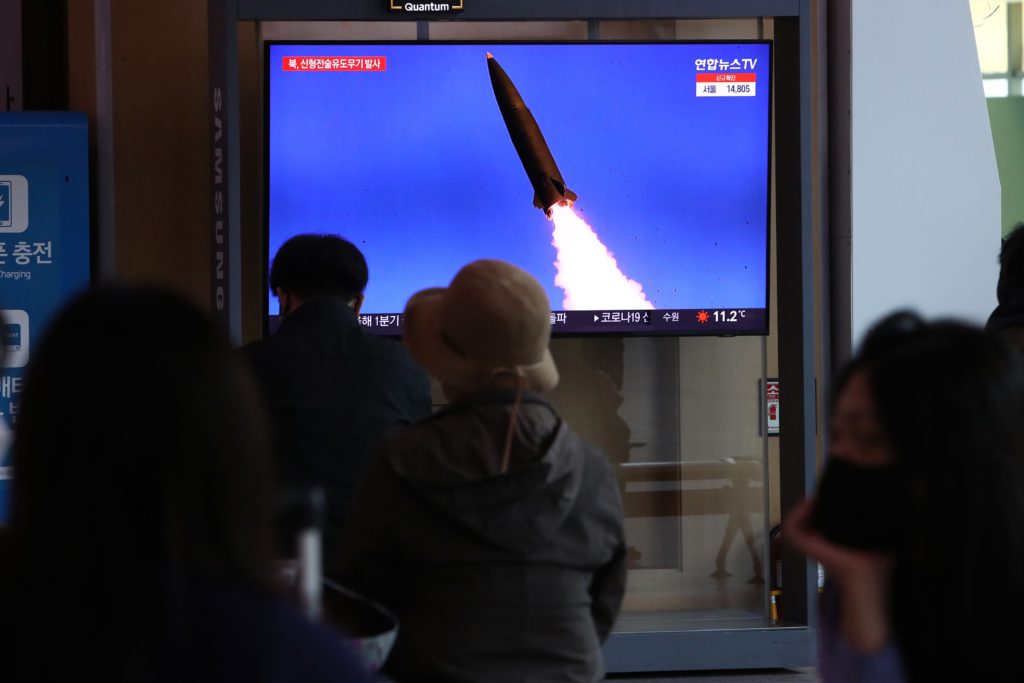(Bloomberg) — North Korea fired a possible mid- to long-range ballistic missile into the sea off its eastern coast, the Yonhap New Agency said, after Kim Jong Un pledged to accelerate the development of his nuclear program.
The projectile was launched from a Pyongyang-area site near where Kim in March test-launched his first intercontinental ballistic missile in more than four years, Yonhap said, without citing anyone. The launch was separately confirmed by the South Korean and Japanese governments, with Japan’s Coast Guard saying the projectile was probably a ballistic missile.
The launch comes after Kim vowed at a military parade last week in Pyongyang to speed up the development of his weapons program. U.S. President Joe Biden is expected to make his first visit to Seoul as president later this month, after months of failed overtures to Pyongyang to restart talks.
“North Korea seems to have resumed its martial protests before Biden’s visit to South Korea later this month and as U.S. deploys its strategic assets around the Korean Peninsula,” said Cheon Seong-whun, a former security strategy secretary for South Korea’s presidential office.
In late March, North Korea fired an ICBM that reached an altitude of 6,200 kilometers (3,900 miles) and traveled 1,080 kilometers to splash down in the sea to the west of Japan, which was higher and farther than North Korea’s last successful ICBM test in November 2017.
North Korea tried to deceive the world about the type of missile it fired, claiming that it successfully tested a “huge,” new ICBM while actually firing off the same rocket launched four years earlier, South Korean defense officials said.
Kim Jong Un Lied About Firing Newer Version of ICBM, Seoul Says
North Korea claimed it fired a Hwasong-17, which is first unveiled in an October 2020 military parade. Weapons experts described it as the world’s largest road-mobile ICBM and it appeared designed to carry a payload of multiple nuclear warheads to the U.S. mainland.
South Korea said its neighbor likely fired off a Hwasong-15 on March 24, which is thought to be able to deliver a single warhead to all of the U.S. mainland, after a failed launch on March 16 of a Hwasong-17.
On April 17, it fired two projectiles that flew about 110 kms, which Pyongyang said were a new type of tactical guided weapon. The range was far less than that of its short-range ballistic missiles.
North Korea Test Fires Missiles Ahead of U.S.-S. Korea Drills
Over the past several months, Kim’s regime has tested a variety of missiles designed to evade U.S.-operated interceptors and increase the threat of a credible nuclear strike against the U.S. and its allies in Asia.
Biden is scheduled to visit South Korea on May 20. Any display of the weapons in Kim’s nuclear arsenal would serve as a reminder of the pressing security problems posed by Pyongyang that have simmered as his administration has been focused on Russia’s invasion of Ukraine.
Kim enacted a self-imposed moratorium on tests of nuclear devices and intercontinental ballistic missiles that could deliver a warhead to the U.S. mainland to facilitate talks with then President Donald Trump in 2018. The two met three times and their discussions resulted in no tangible steps to wind down Pyongyang’s atomic arsenal — which only grew larger as their talks sputtered.
How Kim Jong Un Keeps Advancing His Nuclear Program: QuickTake
Satellite imagery indicates Pyongyang has been restoring tunnels at the Punggye-ri site where it conducted all six of its previous nuclear tests, in what could be the harbinger of an imminent test of an atomic device.
More stories like this are available on bloomberg.com
©2022 Bloomberg L.P.











